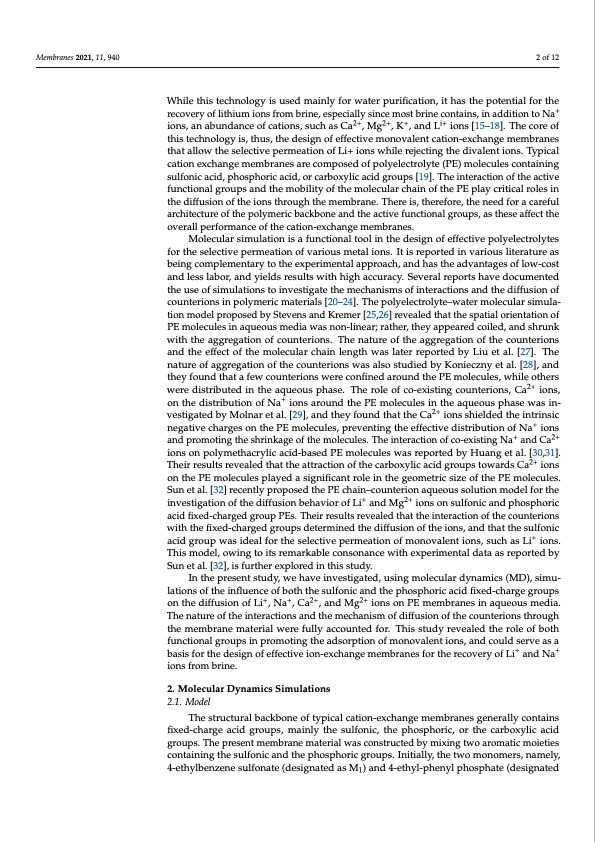
PDF Publication Title:
Text from PDF Page: 002
Membranes 2021, 11, 940 2 of 12 While this technology is used mainly for water purification, it has the potential for the recovery of lithium ions from brine, especially since most brine contains, in addition to Na+ ions, an abundance of cations, such as Ca2+, Mg2+, K+, and Li+ ions [15–18]. The core of this technology is, thus, the design of effective monovalent cation-exchange membranes that allow the selective permeation of Li+ ions while rejecting the divalent ions. Typical cation exchange membranes are composed of polyelectrolyte (PE) molecules containing sulfonic acid, phosphoric acid, or carboxylic acid groups [19]. The interaction of the active functional groups and the mobility of the molecular chain of the PE play critical roles in the diffusion of the ions through the membrane. There is, therefore, the need for a careful architecture of the polymeric backbone and the active functional groups, as these affect the overall performance of the cation-exchange membranes. Molecular simulation is a functional tool in the design of effective polyelectrolytes for the selective permeation of various metal ions. It is reported in various literature as being complementary to the experimental approach, and has the advantages of low-cost and less labor, and yields results with high accuracy. Several reports have documented the use of simulations to investigate the mechanisms of interactions and the diffusion of counterions in polymeric materials [20–24]. The polyelectrolyte–water molecular simula- tion model proposed by Stevens and Kremer [25,26] revealed that the spatial orientation of PE molecules in aqueous media was non-linear; rather, they appeared coiled, and shrunk with the aggregation of counterions. The nature of the aggregation of the counterions and the effect of the molecular chain length was later reported by Liu et al. [27]. The nature of aggregation of the counterions was also studied by Konieczny et al. [28], and they found that a few counterions were confined around the PE molecules, while others were distributed in the aqueous phase. The role of co-existing counterions, Ca2+ ions, on the distribution of Na+ ions around the PE molecules in the aqueous phase was in- vestigated by Molnar et al. [29], and they found that the Ca2+ ions shielded the intrinsic negative charges on the PE molecules, preventing the effective distribution of Na+ ions and promoting the shrinkage of the molecules. The interaction of co-existing Na+ and Ca2+ ions on polymethacrylic acid-based PE molecules was reported by Huang et al. [30,31]. Their results revealed that the attraction of the carboxylic acid groups towards Ca2+ ions on the PE molecules played a significant role in the geometric size of the PE molecules. Sun et al. [32] recently proposed the PE chain–counterion aqueous solution model for the investigation of the diffusion behavior of Li+ and Mg2+ ions on sulfonic and phosphoric acid fixed-charged group PEs. Their results revealed that the interaction of the counterions with the fixed-charged groups determined the diffusion of the ions, and that the sulfonic acid group was ideal for the selective permeation of monovalent ions, such as Li+ ions. This model, owing to its remarkable consonance with experimental data as reported by Sun et al. [32], is further explored in this study. In the present study, we have investigated, using molecular dynamics (MD), simu- lations of the influence of both the sulfonic and the phosphoric acid fixed-charge groups on the diffusion of Li+, Na+, Ca2+, and Mg2+ ions on PE membranes in aqueous media. The nature of the interactions and the mechanism of diffusion of the counterions through the membrane material were fully accounted for. This study revealed the role of both functional groups in promoting the adsorption of monovalent ions, and could serve as a basis for the design of effective ion-exchange membranes for the recovery of Li+ and Na+ ions from brine. 2. Molecular Dynamics Simulations 2.1. Model The structural backbone of typical cation-exchange membranes generally contains fixed-charge acid groups, mainly the sulfonic, the phosphoric, or the carboxylic acid groups. The present membrane material was constructed by mixing two aromatic moieties containing the sulfonic and the phosphoric groups. Initially, the two monomers, namely, 4-ethylbenzene sulfonate (designated as M1) and 4-ethyl-phenyl phosphate (designatedPDF Image | Diffusion of Monovalent Ions in Polyelectrolyte

PDF Search Title:
Diffusion of Monovalent Ions in PolyelectrolyteOriginal File Name Searched:
membranes-11-00940-v2.pdfDIY PDF Search: Google It | Yahoo | Bing
Product and Development Focus for Infinity Turbine
ORC Waste Heat Turbine and ORC System Build Plans: All turbine plans are $10,000 each. This allows you to build a system and then consider licensing for production after you have completed and tested a unit.Redox Flow Battery Technology: With the advent of the new USA tax credits for producing and selling batteries ($35/kW) we are focussing on a simple flow battery using shipping containers as the modular electrolyte storage units with tax credits up to $140,000 per system. Our main focus is on the salt battery. This battery can be used for both thermal and electrical storage applications. We call it the Cogeneration Battery or Cogen Battery. One project is converting salt (brine) based water conditioners to simultaneously produce power. In addition, there are many opportunities to extract Lithium from brine (salt lakes, groundwater, and producer water).Salt water or brine are huge sources for lithium. Most of the worlds lithium is acquired from a brine source. It's even in seawater in a low concentration. Brine is also a byproduct of huge powerplants, which can now use that as an electrolyte and a huge flow battery (which allows storage at the source).We welcome any business and equipment inquiries, as well as licensing our turbines for manufacturing.| CONTACT TEL: 608-238-6001 Email: greg@infinityturbine.com | RSS | AMP |